Ploceus
Ploceus is a genus of birds in the weaver family, Ploceidae. They are native to the Indomalayan and Afrotropical realms.
| Ploceus | |
|---|---|
_(14748527162).jpg.webp) | |
| Bocage's weaver (P. temporalis) and Bertram's weaver (P. bertrandi) ♀ | |
| Scientific classification | |
| Domain: | Eukaryota |
| Kingdom: | Animalia |
| Phylum: | Chordata |
| Clade: | Dinosauria |
| Class: | Aves |
| Order: | Passeriformes |
| Family: | Ploceidae |
| Genus: | Ploceus Cuvier, 1816 |
| Type species | |
| Loxia philippina[1] Linnaeus, 1766 | |
| Species | |
|
See text | |
| Synonyms[2] | |
| |
Taxonomy and systematics
Phylogeny
The genus Ploceus was introduced by the French naturalist Georges Cuvier in 1816.[3] The type species was subsequently designated as the baya weaver.[4] The genus name is from Ancient Greek πλοκευς plokeus meaning "weaver", and is derived from the Greek word πλεκω plekō "to entwine".[5]
Based on recent DNA-analysis, the genus Ploceus is almost certainly polyphyletic. If all species currently included in the genus would remain and the genus would be made monophyletic, it would have to encompass the entire subfamily Ploceinae. The Ploceinae can be divided into two groups. In the first group, the widowbirds and bishops (genus Euplectes) are sister to a clade in which the genera Foudia and Quelea are closest relatives and which further includes the Asiatic species of Ploceus, i.e. P. manyar, P. philippinus, P. benghalensis, P. megarhynchus, (and P. hypoxanthus, although untested). Since Georges Cuvier picked P. philippinus as the type species, these five species would logically remain assigned to the genus Ploceus.
Basic to the second group is a clade consisting of both species so far included in Ploceus that live on Madagascar, P. nelicourvi and P. sakalava, and these are morphologically very distinct from the remaining species. These two species could in future be assigned to the genus Nelicurvius that was erected by Charles Lucien Bonaparte in 1850, but which was merged with Ploceus later on. This second group further contains the genera Malimbus and Anaplectes, and all remaining Ploceus species. As Malimbus is the earlier name, erected by Vieillot et al. in 1805, the remaining species of Ploceus, as well as Anaplectes rubiceps, could in future be assigned to Malimbus.[6] These changes are largely corroborated by morphological revisions.[7][8] Provided that the other genera that have not been proposed to be merged into an extended "Malimbus" are monophyletic, the following (incomplete) tree expresses current insights.
| subfamily Ploceinae |
| ||||||||||||||||||||||||||||||||||||||||||||||||||||||||||||||||||||||||||||||||||||||||||||||||||||||||||||||||||||||||||||||||||||||||||||||||||||||||||||||||||||||||||||||||||||||||||||||||||||||||||||||||||||||||||||||||||||||||||||||||||||||||||||
Species list
_(14745658961).jpg.webp)
The genus contains 68 species.[9]
| Image | Common name | Scientific name | Distribution |
|---|---|---|---|
.jpg.webp) | Baglafecht weaver | Ploceus baglafecht | eastern and central Africa |
.jpg.webp) | Bannerman's weaver | Ploceus bannermani | Cameroon and Nigeria. |
 | Bates's weaver | Ploceus batesi | Cameroon. |
| Black-chinned weaver | Ploceus nigrimentus | Bailundu Highlands of western Angola, on the Batéké Plateau in Republic of the Congo, and in eastern Gabon. | |
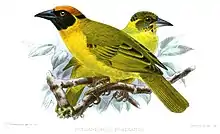 | Bertram's weaver | Ploceus bertrandi | Malawi, Mozambique, Tanzania, and Zambia. |
 | Slender-billed weaver | Ploceus pelzelni | western Africa. |
| Loango weaver | Ploceus subpersonatus | Angola, Republic of the Congo, Democratic Republic of the Congo, and Gabon. | |
.jpg.webp) | Little weaver | Ploceus luteolus | western, central and eastern Africa. |
 | Spectacled weaver | Ploceus ocularis | central, eastern and south-eastern Africa |
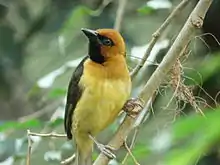 | Black-necked weaver | Ploceus nigricollis | tropical Africa from Senegal and northern Angola to South Sudan and Tanzania. |
.jpg.webp) | Olive-naped weaver | Ploceus brachypterus | West Africa from Senegal and Gambia to Camaroon.. |
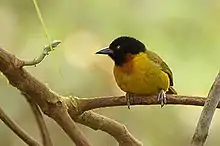 | Strange weaver | Ploceus alienus | Albertine Rift montane forests. |
.jpg.webp) | Black-billed weaver | Ploceus melanogaster | central Africa. |
.jpg.webp) | Cape weaver | Ploceus capensis | southern Africa. |
_(14748527162)%252C_Ploceus_temporalis.jpg.webp) | Bocage's weaver | Ploceus temporalis | Angola, southern Democratic Republic of the Congo and northwestern Zambia. |
.jpg.webp) | Eastern golden weaver | Ploceus subaureus | eastern and south-eastern Africa. |
_(22561083782).jpg.webp) | Holub's golden weaver | Ploceus xanthops | Gabon to Uganda and Kenya, south to northern Namibia, northern Botswana and eastern South Africa |
.jpg.webp) | Orange weaver | Ploceus aurantius | western and central Africa. |
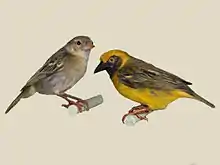 | Heuglin's masked weaver | Ploceus heuglini | Senegal, Gambia and Mali to Ivory Coast and east to Uganda and western Kenya. |
.jpg.webp) | Golden palm weaver | Ploceus bojeri | eastern Africa. |
 | Taveta weaver | Ploceus castaneiceps | African Savannah in Kenya and Tanzania. |
_male.jpg.webp) | Príncipe weaver | Ploceus princeps | São Tomé and Príncipe |
_(45671971275).jpg.webp) | Northern brown-throated weaver | Ploceus castanops | Uganda, Rwanda and adjacent northern Burundi, eastern Democratic Republic of the Congo, western Kenya and northwestern Tanzania. |
_male.jpg.webp) | Southern brown-throated weaver | Ploceus xanthopterus | southern Africa. |
| Ruvu weaver | Ploceus holoxanthus | eastern Africa. | |
| Kilombero weaver | Ploceus burnieri | Tanzania. | |
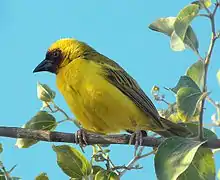 | Rüppell's weaver | Ploceus galbula | Sudan to Somalia and extreme northern Kenya. |
_male.jpg.webp) | Northern masked weaver | Ploceus taeniopterus | Democratic Republic of the Congo, Ethiopia, Kenya, and Sudan. |
.jpg.webp) | Lesser masked weaver | Ploceus intermedius | eastern, south-eastern and southern Africa. |
 | Southern masked weaver | Ploceus velatus | southern Africa. |
.jpg.webp) | Katanga masked weaver | Ploceus katangae | south-eastern Democratic Republic of the Congo and northern Zambia. |
| Lufira masked weaver | Ploceus ruweti | Democratic Republic of the Congo. | |
| Tanzanian masked weaver | Ploceus reichardi | south-western Tanzania and north-eastern Zambia. | |
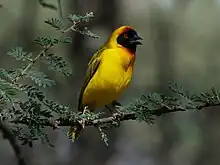 | Vitelline masked weaver | Ploceus vitellinus | western, central and eastern Africa. |
.jpg.webp) | Speke's weaver | Ploceus spekei | northern and eastern Somalia, Ethiopia, Kenya, and north-eastern Tanzania |
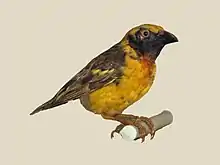 | Fox's weaver | Ploceus spekeoides | Uganda. |
_male.jpg.webp) | Village weaver | Ploceus cucullatus | Sub-Saharan Africa; introduced to Hispaniola, Dominica, Mauritius and Réunion. |
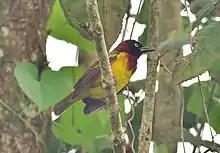 | Giant weaver | Ploceus grandis | São Tomé Island. |
_male.jpg.webp) | Chestnut-and-black weaver | Ploceus castaneofuscus | western and central Africa |
.jpg.webp) | Vieillot's black weaver | Ploceus nigerrimus | West Africa |
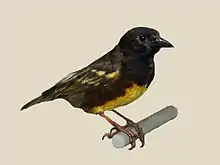 | Weyns's weaver | Ploceus weynsi | eastern Democratic Republic of the Congo and north-western Tanzania. |
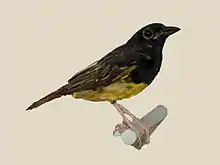 | Clarke's weaver | Ploceus golandi | Kenya. |
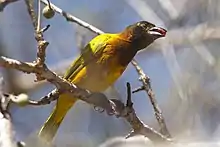 | Juba weaver | Ploceus dichrocephalus | Horn of Africa. |
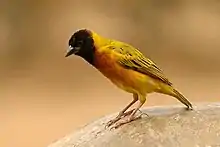 | Black-headed weaver | Ploceus melanocephalus | West, Central, and East Africa |
.jpg.webp) | Golden-backed weaver | Ploceus jacksoni | Burundi, Kenya, South Sudan, Tanzania, and Uganda. |
| Cinnamon weaver | Ploceus badius | Sudan and South Sudan | |
_male.jpg.webp) | Chestnut weaver | Ploceus rubiginosus | eastern and south-western Africa. |
| Golden-naped weaver | Ploceus aureonucha | northeastern Democratic Republic of the Congo. | |
.jpg.webp) | Yellow-mantled weaver | Ploceus tricolor | African tropical rainforest. |
 | Maxwell's black weaver | Ploceus albinucha | African tropical rainforest. |
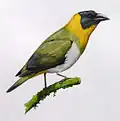 | Nelicourvi weaver | Ploceus nelicourvi | Madagascar |
 | Sakalava weaver | Ploceus sakalava | Madagascar. |
_(2)_(cropped).jpg.webp) | Asian golden weaver | Ploceus hypoxanthus | Cambodia, Indonesia, Laos, Myanmar, Thailand, and Vietnam. |
_(cropped).jpg.webp) | Compact weaver | Ploceus superciliosus | Angola, Benin, Burkina Faso, Burundi, Cameroon, Central African Republic, Republic of the Congo, Democratic Republic of the Congo, Ivory Coast, Ethiopia, Gabon, Ghana, Guinea, Guinea-Bissau, Kenya, Liberia, Nigeria, Rwanda, Senegal, Sierra Leone, Sudan, Tanzania, Togo, Uganda, and Zambia. |
 | Black-breasted weaver | Ploceus benghalensis | South Asia |
_(37514260752).jpg.webp) | Streaked weaver | Ploceus manyar | Bangladesh, Bhutan, Cambodia, China, Egypt, India, Indonesia, Myanmar, Nepal, Pakistan, Singapore, Sri Lanka, Thailand, Vietnam |
.jpg.webp) | Baya weaver | Ploceus philippinus | Indian Subcontinent and Southeast Asia. |
 | Finn's weaver | Ploceus megarhynchus | India and Nepal |
.jpg.webp) | Dark-backed weaver | Ploceus bicolor | Angola, Burundi, Cameroon, Republic of the Congo, Democratic Republic of the Congo, Equatorial Guinea, Eswatini, Gabon, Kenya, Malawi, Mozambique, Nigeria, Rwanda, Somalia, South Africa, South Sudan, Tanzania, Uganda, Zambia, and Zimbabwe. |
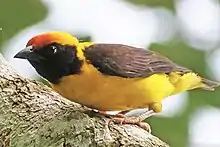 | Preuss's weaver | Ploceus preussi | Cameroon, Central African Republic, Republic of the Congo, DRC, Ivory Coast, Equatorial Guinea, Gabon, Ghana, Guinea, Liberia, and Sierra Leone. |
| Yellow-capped weaver | Ploceus dorsomaculatus | Cameroon, Central African Republic, Republic of the Congo, Democratic Republic of the Congo, and Gabon. | |
.jpg.webp) | Olive-headed weaver | Ploceus olivaceiceps | Malawi, Mozambique, Tanzania, and Zambia. |
| Usambara weaver | Ploceus nicolli | Tanzania. | |
_(cropped).jpg.webp) | Brown-capped weaver | Ploceus insignis | Angola, Burundi, Cameroon, Republic of the Congo, Democratic Republic of the Congo, Equatorial Guinea, Kenya, Nigeria, Rwanda, South Sudan, Tanzania, and Uganda. |
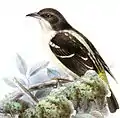 | Bar-winged weaver | Ploceus angolensis | Angola, Democratic Republic of the Congo, and Zambia. |
_(cropped).jpg.webp) | São Tomé weaver | Ploceus sanctithomae | São Tomé and Príncipe. |
| Yellow-legged weaver | Ploceus flavipes | Democratic Republic of the Congo. | |
References
- "Ploceidae". aviansystematics.org. The Trust for Avian Systematics. Retrieved 2023-07-16.
- "Ploceus". Global Biodiversity Information Facility. Retrieved 16 February 2022.
- Cuvier, Georges (1816). Le Règne animal distribué d'après son organisation : pour servir de base a l'histoire naturelle des animaux et d'introduction a l'anatomie comparée (in French). Vol. 1. Paris: Déterville. p. 383.
- Mayr, Ernst; Greenway, James C. Jr, eds. (1962). Check-list of birds of the world. Vol. 15. Cambridge, Massachusetts: Museum of Comparative Zoology. p. 32.
- Jobling, J.A. (2018). del Hoyo, J.; Elliott, A.; Sargatal, J.; Christie, D.A.; de Juana, E. (eds.). "Key to Scientific Names in Ornithology". Handbook of the Birds of the World Alive. Lynx Edicions. Retrieved 5 May 2018.
- De Silva, Thilina N.; Peterson, A. Townsend; Bates, John M.; Fernandoa, Sumudu W.; Girard, Matthew G. (2017). "Phylogenetic relationships of weaverbirds (Aves: Ploceidae): A first robust phylogeny based on mitochondrial and nuclear markers". Molecular Phylogenetics and Evolution. 109: 21–32. doi:10.1016/j.ympev.2016.12.013. PMID 28012957. S2CID 205841906.
- Wolters, H.E. (1970). "On the generic classification of the weaver-birds of the Malimbus-Ploceus group" (PDF). Natural History Bulletin of the Siam Society. 23: 369–391.
- Del Hoyo, J.; Elliott, A.; Christie, D. (2010). Handbook of the Birds of the World. Vol. 15. Weavers to New World Warblers. Barcelona: Lynx Edicions.
- Gill, Frank; Donsker, David; Rasmussen, Pamela, eds. (January 2023). "Old World sparrows, snowfinches, weavers". IOC World Bird List Version 13.1. International Ornithologists' Union. Retrieved 7 February 2023.

_(6040990915).jpg.webp)
_(1).jpg.webp)
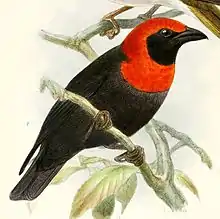
_(8390429318).jpg.webp)
_male_(32762140665)%252C_crop.jpg.webp)